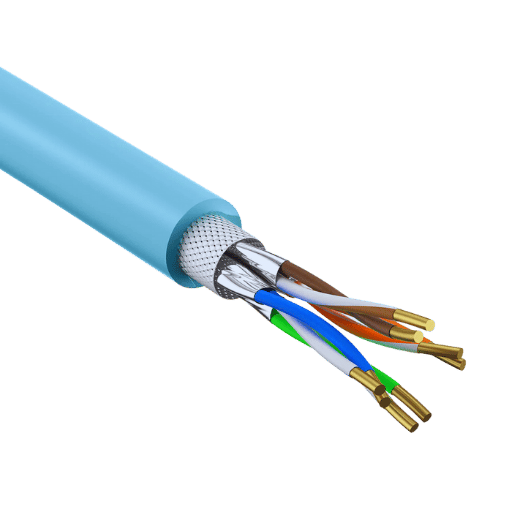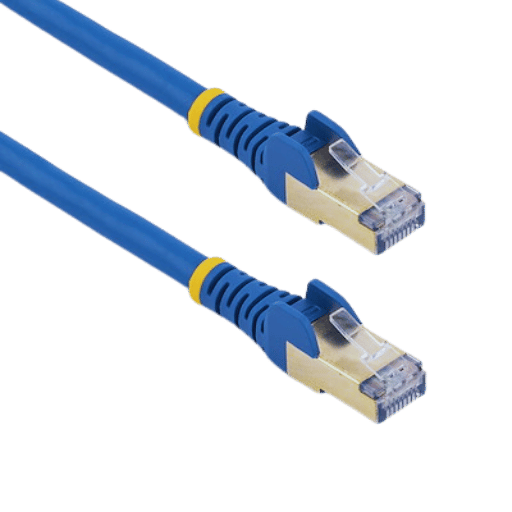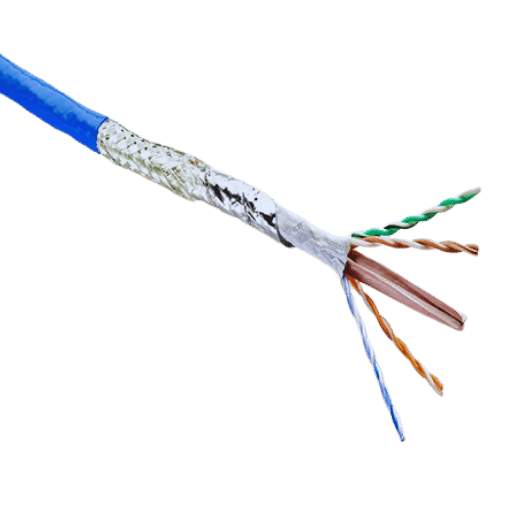Choosing the correct Ethernet cable has become extremely essential in both personal and professional contexts due to technological advancements and the growing demand for fast and reliable internet connections. In this post, we will focus on Cat 6a Ethernet cables, discussing their unique characteristics, advantages in performance, and use cases vis-à-vis Cat 6 cables. Our goal is to help you understand when it may be best to opt for cat6a instead of any other types, such as cat5 or cat5e, especially if you are looking forward to having more bandwidth availability while still maintaining signal strength over longer distance ranges up to around 328 ft (100m). Whether setting up home networks or configuring corporate infrastructures at scale, these guidelines should give enough information so that one can make informed decisions about which type(s) would work best under different circumstances.

Even though both are used as network cables, Cat 6a cable, and Cat 6 cable vary greatly in their performance and application. As much as they can transfer data to a maximum of 1 Gbps within a distance of 100 meters with frequency coverage of up to 250 MHz, Cat six cables, however on the other hand can only handle this transfer rate for the same distance but at frequencies not exceeding 500 MHz while still supporting up-to ten gigabits per second over the entire length. This better quality design is what enables such an improvement in performance, which includes things like reducing crosstalk as well as having better insulation, among other things, making them more suitable for use in areas where there could be higher traffic volumes or even those that want to be prepared for technological advancements that may arise in future.
When it comes to data transfer and speed between Category 6 (Cat 6) and Category 6a (Cat 6a) cables, the technical differences become clear in specific measures and abilities.
Data Transfer Speeds and Distance
Crosstalk and Interference
Future-Proofing and Scalability
Use Case Scenarios
In short, cat-06a has better data transfer speeds, less interference, and future-proofing capabilities than cat six, making it more suitable for high-performance networks.
While coming to a decision between Cat 6 and Cat 6a for office or home networks, there are a number of aspects that need to be considered.

Cat 6a Ethernet cables are important in increasing the bandwidth. They do this by facilitating data transmission with a speed of up to 10 Gbps at 500 MHz which doubles the frequency range of Cat 6. Such large capacity for high-speed communication ensures the quick transfer of information that is vital for programs involving massive amounts of data like live streaming videos, sending large files, and real-time data processing. Moreover, the wider frequency spectrum, together with better insulation against interference provided by these types of wires, reduces signal loss as well as cross-talk between adjacent channels, thereby ensuring strong and reliable connections even over extended distances of up to one hundred meters.
A more effective shield in Cat 6a cables makes them work better by limiting electromagnetic interference (EMI) and lessening crosstalk with nearby wires. In most cases, this involves overall as well as individual shields for each wire pair, which protects signal integrity and enables reliable high-speed data transfer. This means fewer mistakes over greater distances, so they are good for places with lots of electrical noise or when speed needs to be steady.
Yes, it is true that Cat 6a cables can work with Cat 5e and Cat 6 networks. In this context, Cat 6a cables are backward compatible with Cat 5e and Cat 6 cables according to modern cable standards where they also perform better than the latter. They make use of RJ45 connectors, which are the Ethernet connection standard; hence, they can fit into existing ports or equipment of a cat5e or cat6 without requiring any modifications. However, even though these cables operate within performance limits for systems designed under categories five E and six, such systems need all components (including hardware) to be compatible with higher-level specifications of category six shielded twisted pair cabling if more advanced features like wider channels or improved shielding are to be realized.

Evaluating some key features to ensure performance and compatibility is done when choosing a Cat 6a Ethernet cable for your needs.
Cable Length and Performance
The length of a cable affects the performance of Cat 6a cables. In fact, it supports 10 Gigabit Ethernet up to distances of 100 meters however beyond this point signal quality may start deteriorating. Therefore, it is important to accurately measure how long you need your cable to be and select one that has minimum signal attenuation within that distance; typically recommended for longer runs are category 6a cables.
Shielding Type
Shielding options available with CAT6As include Shielded Twisted Pair (STP), Foiled Twisted Pair (FTP), Unshielded Twisted Pair (UTP), etceteras; each used depending on various needs such as prevention from electromagnetic interference cross-talk among others due to high electrical noise environments like industries where stronger shieldings such as STP or FTP would be more appropriate while UTP being enough in residential areas which have less electricity-congested surroundings but if you want extra protection then there is no harm in going for even higher levels provided by Cat 6a 10G shielded cables.
Jacket Material
The outer jacket material can affect durability and suitability for different environments, and so does the cat6a cables. For example, PVC(Polyvinyl Chloride) jackets are good enough indoors where nothing much happens but LSZH (Low Smoke Zero Halogen) jackets should be used in places with safety concerns as they emit few toxic fumes when burned, thus contributing little towards air pollution unlike other materials that release large amounts of smoke during combustion; outdoor cabling made from polyethylene will withstand harsh weather conditions hence keeping them safe from damage especially if installed underground or overhead lines exposed directly to sunlight rain water etcetera which may corrode their covering leading further weakening over time thereby compromising on reliability especially when trying to maintain CAT6a integrity outdoor.
Bandwidth and Speed Requirements
Understand what bandwidths you require from your network and how fast data needs to be transferred. Cat 6a cables support up to 500 MHz bandwidth, which is enough for 10 Gigabit Ethernet. That implies they are good at handling high-speed applications as well as allowing you to future-proof against possible upgrades in the near future thus if these features match with other devices within your environment like switches, routers among others then it will help realize full potential benefits associated with improved performance brought about by Category six a.
Compliance with Standards
Make sure any cat6a cable bought adhere to set standards, namely TIA/EIA-568-B.2-10 and ISO/IEC 11801; this guarantees their appropriateness for structured cabling systems where they are expected to perform reliably without compromising on consistency or even reliability of networks connected through them thus enabling smooth flow communication across various sections within given buildings while still maintaining certain levels of quality assurance during transmission processes which can easily be achieved if only these guidelines were followed strictly.
Cost Considerations
Cat 6A may cost more than Cat five Enhanced or Six according to its brand name, but do not let price fool one into thinking that it lacks benefits provided by higher categories, such as future-proofing capabilities, among others because sometimes investing extra cash now saves lots later, especially when dealing with long term needs concerning network scalability so weigh budget against system requirements plus take note custom lengths could affect pricing considerably alongside bulk purchases available too at different rates thereby affecting total cost efficacy in general terms.
By following these factors, robustness as well speediness in sendingdata packets through variousnetwork loops can be achieved thanks to choosing theright category six a ethernet cable mostsuitablefor ones ownspecific networkingrequirements.
Unshielded Twisted Pair (UTP)
Twisted pairs that lack shielding are used in making UTP Cat 6a cables. They usually cost less and are easier to fit owing to their bendability. UTP cables are the best choice for typical network settings where there is little electromagnetic interference (EMI). What they do is twist the pairs together so as to minimize crosstalk and EMI.
Shielded
Shielded Cat 6a cables have an outer shield that protects against EMI more than this does for additional twisting. These kinds of wires can be used in places with lots of interference, such as industries or data centers that have many electrical appliances. The performance of these cables is improved by shielding them because it guards against signal degradation, especially over long distances. However, due to extra shielding, these cords may become thicker and less flexible, thereby complicating installation processes.
Once you know what sets UTP apart from Shielded Cat 6a cables, choose the appropriate one based on your specific network environment and performance needs.
Premium self-generated Ethernet piece cables volunteer various advantages that raise network performance and reliability, especially while using Category 6a cables. These include:
Opting for self-made premium patch cables will enable you to create an efficient, dependable, and long-lived networking structure that suits your individual demands best.

A better choice for places with many data and noise disruptions is made by CAT 6a Ethernet cables because they increase network performance by supporting a maximum distance of 100 meters at a speed of up to 10 Gbps, which adheres to cable standards that are strict. What makes them advanced is their design, where there are more twists and stronger shields than in previous categories, thus reducing crosstalk and electromagnetic interference effectively (EMI). Thus, it becomes possible to transmit data reliably with higher efficiency, i.e., this leads to better or improved where; also, such an environment would experience reliable data transmission frequently compared to other options.
Cat 6a cables are extremely critical in helping to reduce crosstalk and network interference – two of the biggest culprits when it comes to slowing down a network. The shielding in Cat 6a cables is more advanced than that of other categories because it blocks out external electromagnetic interference (EMI) and cuts back on internal crosstalk. This happens by twisting each pair inside the wire more tightly together, as well as adding an extra tough shield around them, which keeps outside noise from getting in contact with the signal wires themselves. Anyways, this ensures clean and steady data transmission; hence, high-speed transfers can go uninterrupted. Cat 6a cables offer superior performance hence they are best suited for environments where there is need for heavy data traffic coupled with minimum interferences. All these factors together work towards reducing overall efficiency and reliability problems related to network infrastructure caused by crosstalks or interferences due to cheap patch cords being used instead of better quality ones like CAT5e or higher standards such as CAT7A which have been designed specifically for this purpose.

Here are some key things to do to make sure that your cat 6a network cable works optimally:
By following these tips, you will have done everything possible to get the most out of your cat6a network cables, which guarantee fast, reliable connection speeds over long distances.
A: The main difference between Cat6 and Cat6a cables is in their performance specifications. For instance, while a 10G speed can be supported by cat 6a cables for up to 100 meters, cat 6 cables only support it for distances not exceeding 55 meters; also, more shielding has been done on cat-6a cables than that which was done on cat-6 ones in order to reduce interference.
A: Yes, backward compatibility exists between these two types of systems i.e., using an Ethernet cable designed for category six A (i.e., Cat six A) will still work if connected onto or into one configured for category six (i.e., cat-6). Nevertheless, it should be noted that overall network performance would then be limited to whichever standard happens to represent the lesser among such categories being employed at any particular moment within said network.
A: If used correctly, they have potential as excellent materials required by such quickly moving digital data packets across various devices situated far apart from each other within campus-wide area networks etcetera because unlike their counterparts whose capabilities are only limited within five meters outside cabinets housing them closer to computers generating signals destined eventually elsewhere over long distances thus requiring reliable transmission media able handle higher bandwidths without breaking down or deteriorating along path length.
A: Generally speaking, it tends to be true that if something offers more benefits, then it will always demand higher prices; hence, cabling made according to these enhanced specifications is likely going forward cost more money per unit of measurement against those created under previous versions’ guidelines or recommendations but this does not necessarily mean one should shy away from investing heavily into upgrading internet connections lest where low data transfer rates between different parts an organization may still suffice provided there no other factors impeding desired outcomes.
A: Yes, they can be used with Power over Ethernet (PoE) applications. For example, if more power and data need to go further distances or reach devices located in areas such as ceilings then using improved performance shielding will help ensure reliable connectivity between end points at longer runs where this may otherwise not have been achieved due interference caused by external sources along path length.
A: Yes, multiple varieties tailored to fit diverse environmental conditions do exist including but not limited to those shielded against ambient electromagnetic interferences which are very rampant within crowded spaces full of cables crisscrossing each other while others are plenum-rated for safety reasons while employed around air handling units within buildings etcetera so that they might comply better with relevant industry standards concerning safety measures required under such scenarios thus ensuring optimal operational efficiency throughout system lifespan beyond just meeting minimum code requirements only.
A: Shielded are protected from potential electrical disturbances while unshielded ones lack this extra safeguard although they tend to be less flexible, making them harder to install into tighter spots involving lots of twists, turns, bends, corners, walls, floors, etcetera; therefore, depending on specific needs either option may prove useful or not necessary at all sometimes even both could serve different purposes altogether according to particular circumstances prevailing time place involved during the installation process itself that being said it would wise consult experts in the field before making any decisions regarding proper choice selection among available alternatives based upon individual case basis.
A: Factors worth considering include required network speed distance level of interference present inside outside building structure cost implications associated with acquiring installing, and maintaining equipment employing either type along with other related issues relevant to overall objective(s) sought achieve through establishment expansion modification upgrade integration, etcetera such considerations become even more critical if there exist multiple options capable meeting similar needs but differing terms performance reliability scalability adaptability compatibility flexibility ease use simplicity installation configuration management troubleshooting diagnosis repair etc.
A: They are not necessary for most home networks. However, they can future-proof the network if you plan on upgrading to higher speed internet or using bandwidth-intensive applications . For regular internet usage cat6 cable will suffice though using a shielded Ethernet cable can improve performance in areas with potential interference.
A: Cat6a Ethernet cables can be purchased from various online and physical electronics stores including specialized networking equipment suppliers; nevertheless ensure buy quality cables which meet performance standards thus always make sure purchase such items reputable sources only.